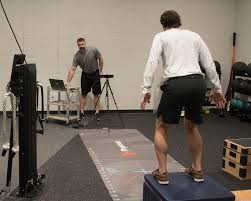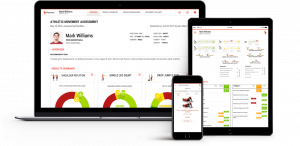Opportunity:
Recovering from an injury is a lengthy process throughout which physical therapy plays a crucial role. The effectiveness and speed of recovery depends not only on the quality of the physical therapy provider but also on how diligently and precisely a patient follows his/her prescribed home exercises. Research shows that lack of compliance with home exercises is a major limitation to the effectiveness of physical therapy, and can slow down an injury recovery process. [1] For example, in a study by Bassett up to 65% of physiotherapy patients were non-adherent or only partially adherent to home exercise regimens as prescribed by their doctors. [2] Additionally, ensuring the accuracy and effectiveness of home exercising is challenging even for patients with the best intentions without the advice and oversight of a physical therapy expert.
Furthermore, it can be challenging for patients to make the most out of in person physical therapy visits. Therapists often oversee multiple patients simultaneously in one room, relying on support from less qualified staff if at all. In the typical model, a physical therapist spends the first 30 minutes of a therapy session with the patient assessing their current needs. Then, the therapist uses this assessment to develop an exercise plan that the patient completes during the second half of the therapy session. During the latter half of the session, the patient is monitored and assisted by additional staff with less training and qualifications. The result is that a patient typically only spends half of a therapy session that s/he is paying for receiving the attention of a qualified specialist. Without enough proper guidance and corrections early on, patients often learn to perform exercises incorrectly, reducing the effectiveness of physical therapy sessions and slowing down the recovery process.
Solution:
APTitude is a software application that combines medical and anatomical science, physical therapy practices, computer vision algorithms and machine learning to help physical therapists track the improvement progress of their patients and suggest improvements or changes to their regiments in real time through regular observations. The technology uses computer vision and machine learning technology to analyze physical movement, identifying nuances in movement patterns by comparing against a database of observations. APTitude provides alerts, tracking and predicts the best individualized physical therapy regimens to help patients recover in the quickest way possible.
Doctors or physical therapists input patient data, the details of the injury, plus the initial exercises into APTitude’s computer system. The patient then performs the exercises in front of a camera (either webcam or smartphone) that monitors his or her movements over a period of time while the program tracks progress, suggesting corrections for proper form, new exercises, or higher levels of intensity based on the level of improvement. Patients will be able to use the program at home outside of regular physical therapy sessions via smartphone app to help them monitor the quality of their home exercises achieving faster progress, which will result in a better overall patient experience with a specific PT location. This will also allow doctors and physical therapists to monitor whether or not the patient has performed the necessary at-home exercises and adjust the regiment based on the patient’s true progress.
APTitude uses machine learning algorithms that continuously attribute certain movements to positive or negative improvement based on the patient’s injury and physical characteristics and evolve with the addition of more users and observations. As APTitude makes more and more observations from different users, its accuracy will further improve. These observations will also be applied to the software’s future ability to prescribe movements for an individual that is showing signs of physical weakness in a movement.
Proof of Concept:
Studies have shown that application of motion capture data to medical practices is feasible. According to an article in the Journal of Physiotherapy & Physical Rehabilitation, neural network architecture produced a model for sets of human motions represented with a mixture of Gaussian density functions. The mean log-likelihood of observed sequences was employed as a performance metric in evaluating the consistency of a subject’s performance relative to the reference dataset of motions. A publically available dataset of human motions captured with Microsoft Kinect was used for validation of the proposed method. The article presents a novel approach for modeling and evaluation of human motions with a potential application in home-based physical therapy and rehabilitation. [8]
Business Model:
Target Customer
Initially, APTitude would primarily target physical therapists, as they would realize the most value through patient compliance and operating cost reduction. As more data is collected and proof points obtained, APTitude would then target insurance companies to a) reach more physical therapists b) have insurance companies take on a portion of the costs so physical therapists and patients receive a subsidy. Insurance providers will be incentivized because of the long-term effect this will have on surgery reductions.
Revenue Stream/Structure
- The software will initially be offered on a free trial basis to PT offices in order to obtain data from those observations.
- Once the 3 month trial period is over we will charge a $100 license fee per PT location and a $7 fee per patient profile on the platform.
- We explored the idea of charging a fee based on total data usage per office, but the fluctuations in payment sizes would disincentivize PT offices from signing up
- There will be a premium version of the software platform that offers new exercises to perform once a patient has reached competency in their initially prescribed exercise regimen to aid faster recovery. How much a patient can progress further outside of the prescribed weekly regimen will be monitored and limited to avoid any potential negative effects.
- If a patient suffers an injury in the future or wants to check their movements, the software can be accessed on their phone with limited capabilities. The program will only tell them if they are injured or needs to consult their PT and where their injury is likely stemming from. This allows the PT to receive more patients through a referral like system and increase their revenue as well as ours.
Effectiveness, Commercial Promise, and Competition:
Initial market research suggests that there is significant opportunity for this product to be commercially successful. The physical therapy market is highly fragmented, lacking clear front-runners; no single market participant controls more than 5%. [5] Currently, it attracts $35 billion in revenues, with 3.9% annual growth. [4] According to the Bureau of Labor Statistics, the job outlook for physical therapists in the next 10 years is 28%, or “much faster than average.” [16] At the same time, patient retention is a significant challenge for physical therapists, and this product has high potential to improve retention rates. By improving patient compliance, we anticipate a decrease in attrition rates, which can be as high as 40% by the seventh outpatient visit.
We believe that macro level trends will provide a tailwind for our business as we have an aging population in the US that are heavy consumers of physical therapy as well as a rising demand for an active lifestyle. These demographic trends along with increased insurance coverage should boost demand for PT. Additionally, people are employed in more sedentary jobs on average, which is leading to physical injuries when going from sitting all day to activity. Average outpatient course of treatment consists of approximately 10 visits, and insurance reimbursement rates and the number of visits approved for PT services are largely stagnant or decreasing. [4]
Job Outlook for Physical Therapy:
Competitors:
Competition for APTitude will vary depending on target market, predictiveness as well as use of hardware and robotics. Organizations such as Bionik Laboratories and Hocoma integrate heavy robotics to evaluate and support physical therapy and rehab of patients with severely impaired patients. Few companies are using AI to develop predictive (along with evaluative) capabilities to support either PT or Sports / Exercise needs, with the exception of PhysiMax that is geared toward professional athletes.
Pilot Program / What funds will be used for:
We are requesting $175K in funding over two years to hire technical experts and create a cloud platform to store our data. Marketing and sales staff will be managed by the founders at no cost.
- Technical experts needed: $100 per hour
- Hardware needed: ~$9,000 a month
- Physical Therapy consultant needed: $50 per hour
- Marketing and sales staff: $0 (Founders)
Pilot:
Step 1 – Our initial pilot will focus on collecting data and monitoring the experiences of 100 physical therapy patients with select physical conditions over the course of their 10-14 week rehabilitation treatments. To do this, we will partner with 2-3 physical therapist practices in Chicago. We will track their progress by assessing their performance of 5-7 movements at the beginning of their course of treatment, at weekly intervals, and at the end of treatment.
Step 2 – The video data collected from the 2-3 physical therapist offices will create a baseline distribution of movement norms. This allows our software to understand how patients should move and what effective movements are.
Step 3 – Once the software is smart enough to understand what correct movements are, it will observe patients’ movements, immediately identify physical deficiencies from this movement, and prescribe individualized movements to help the patient recover.
Future:
Our goal is to saturate the Chicago PT market by partnering with Athletico. Athletico has 57 PT locations in Chicago alone. From there we will try to expand into adjacent markets, starting with Miami, which is home to many elderly individuals at risk of injury.
Financial projections:
Sources:
[1] Journal of Orthopedic and Sports Physical Therapy https://www.jospt.org/doi/pdf/10.2519/jospt.1997.25.2.101
[2] The assessment of patient adherence to phsiotherapy rehabilitation https://www.researchgate.net/profile/Sandra_Bassett/publication/284411604_The_assessment_of_patient_adherence_to_physiotherapy_rehabilitation/links/56afc4cb08ae9c1968b48840/The-assessment-of-patient-adherence-to-physiotherapy-rehabilitation.pdf
What don’t patients do their exercises? Understanding non-compliance with physiotherapy in patients with osteoarthritis of the knee http://jech.bmj.com/content/55/2/132
[6] https://venturebeat.com/2017/10/15/bots-are-becoming-highly-skilled-assistants-in-physical-therapy/
[7] https://www.bioniklabs.com/about/overview
[9] https://arxiv.org/abs/1802.01489
[10] https://www.ncbi.nlm.nih.gov/pmc/articles/PMC2235834/
[11] https://www.ncbi.nlm.nih.gov/pubmed/29283933
[12] https://arxiv.org/ftp/arxiv/papers/1609/1609.07480.pdf
[13] https://phyzio.com
[14] https://pmax.co
[16] https://www.bls.gov/ooh/healthcare/physical-therapists.htm
[17] https://www.vmware.com/cloud-services/pricing-guide.html
Team Members:
Pavlina Plasilova, Kelly de Klerk, Yuxiao Zhang, Aziz Munir, Megan McDonald















